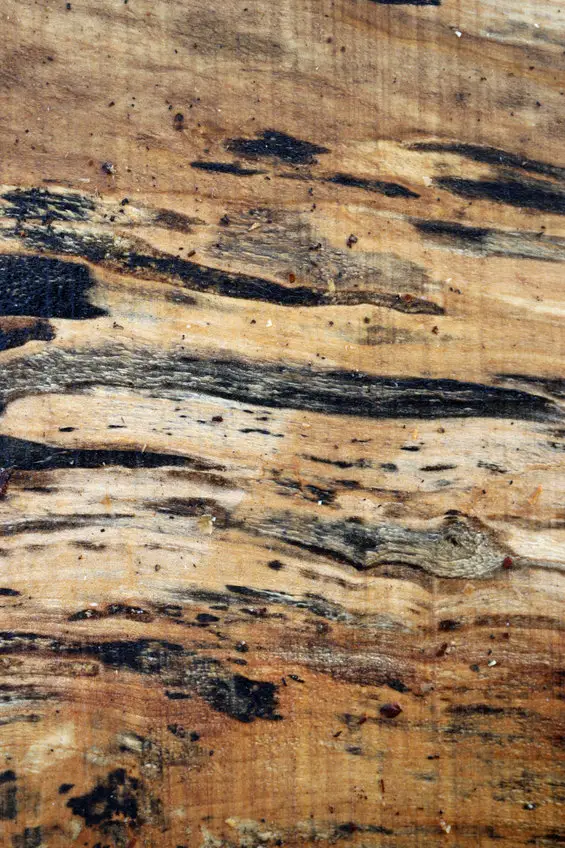Spalted wood is becoming more and more fashionable despite it being the result of naturally occurring fungi that live within tree wood. Despite the attractive and intricate patterns that Spalted wood often displays, there are safety disclaimers that you should know about before working with it.
Spalting is a form of fungus that starts discoloring dead wood and is caused by wood decay. In woodworking, spalting is most desirable when found in birches, beeches, and maples. Some other woods can become discolored by spalting but are less desirable.
Spalting is a form of fungus that starts working its way through dead wood and is caused by wood decay. It also occurs in wood that will allow spalting to naturally occur. This can only happen in wood that includes birches, beeches, and maples. But for the most part, you can also include basswood, buckeye, sycamore, apple, and hickory. In some select cases, it can also happen in walnut but the color is harder to see.

Only when you have red or white oak, will spalting appear even more dramatic, than other types of wood. Yet the key to spalting comes from the fungus that works its way through the wood itself. There are essentially two types of fungus rot that work their way through the wood. This includes White Rot and Blue Stain and both of them have different appearances on wood that’s been affected by these creative fungal rots.
What precautions to take when working with spalted wood?
We all know that fungus can be good for some things since many medicines are formed from fungus. Take a miracle fungus that helped to create Penicillin , but fungus isn’t limited to just one type of medicine that can be derived from fungus. Yet the hazards of fungus are often avoided since they present the danger of becoming ill from them. For this reason, woodworking enthusiasts must take caution when working with spalted wood.
, but fungus isn’t limited to just one type of medicine that can be derived from fungus. Yet the hazards of fungus are often avoided since they present the danger of becoming ill from them. For this reason, woodworking enthusiasts must take caution when working with spalted wood.
Now, here’s the important part of taking the right kind of safety precautions when working with spalted maple and other types of spalted wood. While your wood is still drying, this fungus is still very much alive and can get into the air. You’ll need to wear a face mask or respirator and work in an area that draws away dust or mold spores coming off your wooden piece. Adequate ventilation is important since shaping wood will throw fungus spores into the air.
How to keep mold and fungus out of your lungs?
There are a lot of myths about spalted wood that have been spreading like wildfire on the internet. Ever since the spread of misinformation has become as popular as live-stream gaming, many people will avoid spalted wood because of these internet rumors . The truth of the matter is that when the wood is completely dry, the fungal spores are inactive. This means that the spores cannot be harmful unless they become activated by moisture.
. The truth of the matter is that when the wood is completely dry, the fungal spores are inactive. This means that the spores cannot be harmful unless they become activated by moisture.
Don’t get me wrong. The spores can be dangerous and can be reactivated when in contact with the moisture from your body. Personal protection equipment and ventilation are always recommended when working with any kind of wood, especially spalted wood.
Finished wood including spalted maple, birch, or beech will all be sealed with finishing lacquer, wax, and various wood sealers. After this, the fungus is contained in the wood and will not be dangerous. Even if you have a wooden item in the bathroom where there is moisture or steam, this won’t reactivate the fungus because it’s trapped within the wood from the sealers used. Cutting boards that are made from spalted wood are 100% safe.
Does spalting strengthen or weaken the wood?
Two different types of spalting can happen in wood, but only one of them will start to weaken the wood. Blue Stain spalting is not harmful to the integrity of your wood, which means that White Rot is the real culprit that can cause wood to do things it wasn’t supposed to do. The longer that spalting goes on, the more that the wood itself will start to rot. As it rots, it will begin to loosen and can actually split where the rot has eaten its way through.
One option to help keep the integrity of the wood is to use it as a veneer. Veneers will display the sought-after grain patterns of spalted wood while the sub straight will provide all the strength you need. Veneering will also give the opportunity to book match your thin slices to produce an even more desirable grain pattern.
Seasoned woodworking professionals will know how long they can allow spalting to occur before the wood needs to be used. The methods are all different but the worst will happen if you’re attempting to turn the wood. Cutting with power tools is better, and grinders will reduce the splitting or loosening of spalted areas. When wood has rotted too much it’s totally useless, so there is a refined touch whenever working with White Rot spalted wood.
Can spalted wood be finished the same way regular wood can?
As mentioned before, you need a delicate touch when working with spalted wood. When you see where White rot is running within the wood grain, you need to move in the opposite direction so you can put less stress on that vein. In other words, the amount of care that goes into working spalted wood is like surgery. One wrong cut can result in losing the patient. Using a turning lathe is going to be more problematic since the wood spins so fast.
As far as using finishes, you want to wait until your wood is totally dried before adding any kind of wood lacquer finishes, stains, or waxes. Even after your wood has totally dried, you want to give your wood a good final sanding and cleaning before adding sealers. After these sealers are dried and polished, the wood will be safe to have anywhere in your home.
Can I make spalted wood or is it only found in nature?
Thanks to the magic of introducing fungi spores is a matter of what kind of fungi you want to infect greenwood with. It’s simply not recommended to try fooling around with spalting techniques since you could become sick very easily from mold spores. If you’re very creative, you can cheat this by using a wood-burning tool to create random patterns and veins that worm their way through your wood surface.
with. It’s simply not recommended to try fooling around with spalting techniques since you could become sick very easily from mold spores. If you’re very creative, you can cheat this by using a wood-burning tool to create random patterns and veins that worm their way through your wood surface.
You can also use careful staining using thinned wood stains that simulate Blue Stain spalting. The truth is that nobody will ever be able to tell if you’re very clever and a careful wood finisher. If you’re looking to work with spalted maple and other woods that are already spalting, you can contact local lumber suppliers. Alternatively, you can search for greenwood suppliers that sell spalted wood. Just be sure to practice safety while working with any spalted woods.

